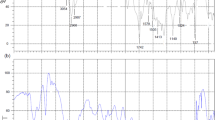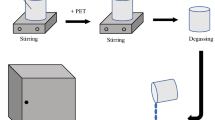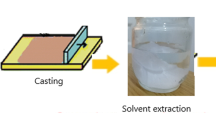Abstract
In this study, the polymeric membranes were prepared using discarded polyethylene terephthalate (PET) bottles. The fabrication of the membrane process was carried out using a dope solution composed of polyethylene terephthalate (polymer), O-cresol (as a solvent), and polyethylene glycol 400 (as an additive). The solubility parameters were studied to dissolve the polymer into the solvent at a specific temperature. The melt flow index and thermal analysis were evaluated for the discarded bottles and prepared membranes to ensure the quality and thermal stability of the PET. The porosity of the membranes was determined using scanning electron microscopy. The temperature required to prepare the dope solution was 80 °C with a stirring speed of 350 rpm. Non-solvent-induced phase separation method was used to fabricate the membranes. The coagulation bath was composed of a water–ethanol mixture. The porosity of the prepared membranes ranges between 30 and 50%. The contact angle was determined for the membrane in the range of 40° to 80°. The flux of the membranes was evaluated using membrane testing cell at a specified pressure which ranges from 80 to 150 Lm−2 h−1. The prepared membranes could be used in various industries like dairy, pharmaceutical, juice, and beverages to separate temperature-sensitive substances.









Similar content being viewed by others
Data availability
The authors confirm that the data supporting the findings of this study are available within the article. Raw data that support the findings of this study are available from corresponding author, upon reasonable request.
References
Al-Ani DM, Al-Ani FH, Alsalhy QF, Ibrahim SS (2021) Preparation and characterization of ultrafiltration membranes from PPSU-PES polymer blend for dye removal. Chem Eng Commun 208:41–59. https://doi.org/10.1080/00986445.2019.1683546
Alvi MAUR, Khalid MW, Ahmad NM et al (2019) Polymer concentration and solvent variation correlation with the morphology and water filtration analysis of polyether sulfone microfiltration membrane. Adv Polym Technol 2019:8074626. https://doi.org/10.1155/2019/8074626
Awaja F, Pavel D (2005) Recycling of PET. Eur Polym J 41:1453–1477. https://doi.org/10.1016/j.eurpolymj.2005.02.005
Bildyukevich A, Plisko T, Shustikov A, et al (2020) Effect of the solvent nature on the structure and performance of poly(amide-imide) ultrafiltration membranes. J Mater Sci 55https://doi.org/10.1007/s10853-020-04714-3
Cassano A, Conidi C, Ruby-Figueroa R, Castro-Muñoz R (2018) Nanofiltration and tight ultrafiltration membranes for the recovery of polyphenols from agro-food by-products. Int J Mol Sci 19https://doi.org/10.3390/ijms19020351
Chen J, Shen L, Zhang M et al (2016) Thermodynamic analysis of effects of contact angle on interfacial interactions and its implications for membrane fouling control. Bioresour Technol 201:245–252. https://doi.org/10.1016/j.biortech.2015.11.063
Chen D, Sirkar KK, Jin C et al (2017) Membrane-based technologies in the pharmaceutical industry and continuous production of polymer-coated crystals/particles. Curr Pharm Des 23:242–249
Dhawan G (2020) About ultrafiltration. Applied Membrane Inc. https://appliedmembranes.com/media/wysiwyg/pdf/systems/about_ultrafiltration_technical_article.pdf. Accessed 10 Jan 2022
Elamri A, Abid K, Harzallah O, Lallam A (2015) Characterization of recycled / virgin PET polymers and their composites. 3:11–16 https://doi.org/10.11648/j.nano.s.2015030401.13
Figoli A, Marino T, Galiano F (2016) Polymeric membranes in biorefinery. In: Figoli A, Cassano A, Basile A (eds) Membrane Technologies for Biorefining. Woodhead Publishing, pp 29–59
Fink JK (2012) Chapter 21 - dispersions, emulsions, and foams. In: Fink JK (ed) Petroleum Engineer’s Guide to Oil Field Chemicals and Fluids. Gulf Professional Publishing, Boston, pp 663–694
Geyer R, Jambeck JR, Law KL (2017) Production, use, and fate of all plastics ever made. Sci Adv 3:e1700782. https://doi.org/10.1126/sciadv.1700782
Hansen CM (1967) The three dimensional solubility parameter and solvent diffusion coefficient. Dissertation, The Polytechnic Danish University of Technology
Hendrix K, Vaneynde M, Vankelecom I (2013) Synthesis of modified poly(ether ether ketone) polymer for the preparation of ultrafiltration and nanofiltration membranes via phase inversion. J Memb Sci 447:96–106. https://doi.org/10.1016/j.memsci.2013.07.006
Imdad S, Dohare RK (2022) A critical review on heavy metals removal using ionic liquid membranes from the industrial wastewater. Chem Eng Process - Process Intensif 173:108812. https://doi.org/10.1016/j.cep.2022.108812
Ismail N, Jakariah N, Bolong N, et al (2017) Effect of polymer concentration on the morphology and mechanical properties of asymmetric polysulfone (PSf) membrane. J Appl Membr Sci Technol 21 https://doi.org/10.11113/amst.v21i1.107
Kahrs C, Gühlstorf T, Schwellenbach J (2020) Influences of different preparation variables on polymeric membrane formation via nonsolvent induced phase separation. J Appl Polym Sci 137:48852. https://doi.org/10.1002/app.48852
Kumar V, Singh R, Ahuja IPS (2022) Use of thermosetting polymers for smart civil structures. In: Encyclopedia of materials: plastics and polymers. Elsevier, pp 662–669. https://doi.org/10.1016/B978-0-12-820352-1.00067-5
Kusumocahyo SP, Ambani SK, Marceline S (2021) Improved permeate flux and rejection of ultrafiltration membranes prepared from polyethylene terephthalate (PET) bottle waste. Sustain Environ Res 31:19. https://doi.org/10.1186/s42834-021-00091-x
Latthe SS, Terashima C, Nakata K, Fujishima A (2014) Superhydrophobic surfaces developed by mimicking hierarchical surface morphology of lotus leaf. Molecules 19:4256–4283. https://doi.org/10.3390/molecules19044256
Li P (2017) Effect of polymer dope concentration on the morphology and performance of PES/PDMS hollow fiber composite membrane for gas separation. Juniper Online J Mater Sci 1:1–5. https://doi.org/10.19080/jojms.2017.01.555573
Ma Y, Shi F, Ma J et al (2011) Effect of PEG additive on the morphology and performance of polysulfone ultrafiltration membranes. Desalination 272:51–58. https://doi.org/10.1016/j.desal.2010.12.054
McKeen L (2012) Introduction to the physical, mechanical, and thermal properties of plastics and elastomers. In: McKeen L (ed) The Effect of Sterilization on Plastics and Elastomers, 3rd edn. William Andrew Publishing, Boston, pp 57–84
Mohammad AW, Ng CY, Lim YP, Ng GH (2012) Ultrafiltration in food processing industry: review on application, membrane fouling, and fouling control. Food Bioprocess Technol 5:1143–1156. https://doi.org/10.1007/s11947-012-0806-9
Mulder M (1997) Basic principles of membrane technology, 2nd edn. Kluwer Academic Publishers, Dordrecht, p 564
Plastics Europe, EPRO (2016) Plastics – the facts 2016: an analysis of European plastics production, demand and waste data. PlasticsEurope. https://plasticseurope.org/wp-content/uploads/2021/10/2016-Plastic-the-facts.pdf. Accessed 20 Jan 2022
Pulido BA, Habboub OS, Aristizabal SL et al (2019) Recycled poly(ethylene terephthalate) for high temperature solvent resistant membranes. ACS Appl Polym Mater 1:2379–2387. https://doi.org/10.1021/acsapm.9b00493
Rabiee H, Vatanpour V, Borghei SM (2015) Fouling reduction of emulsion polyvinylchloride ultrafiltration membranes blended by PEG: The effect of additive concentration and coagulation bath temperature. Desalin water Treat 57. https://doi.org/10.1080/19443994.2015.1048739
Rajesh S, Murthy ZVP (2014) Ultrafiltration membranes from waste polyethylene terephthalate and additives: synthesis and characterization. Quim Nova 37:653–657. https://doi.org/10.5935/0100-4042.20140097
Singh R (2015) Introduction to membrane technology. Membrane technology and engineering for water purification, pp 1–80. https://doi.org/10.1016/b978-0-444-63362-0.00001-x
Sofiah H, Nora`aini A, Marinah MA (2010) The influence of polymer concentration on performance and morphology of asymmetric ultrafiltration membrane for lysozyme separation. J Appl Sci 10:3325–3330. https://doi.org/10.3923/jas.2010.3325.3330
Spear MJ, Eder A, Carus M (2015) Wood polymer composites. In: Ansell MP (ed) Wood Composites. Woodhead Publishing, pp 195–249
Sulyman M, Haponiuk J, Formela K (2016) Utilization of recycled polyethylene terephthalate (PET) in engineering materials: a review. Int J Environ Sci Dev 7:100–108. https://doi.org/10.7763/ijesd.2016.v7.749
Tiab D, Donaldson EC (2012) Wettability. In: Tiab D, Donaldson EC (eds) Petrophysics, 3rd edn. Gulf Professional Publishing, Boston, pp 371–418
Wang C, Xiao C, Huang Q, Pan J (2015) A study on structure and properties of poly(p-phenylene terephthamide) hybrid porous membranes. J Memb Sci 474:132–139. https://doi.org/10.1016/j.memsci.2014.09.055
Williams M (2013) The Merck Index: an encyclopedia of chemicals, drugs, and biologicals, 15th Edition Edited by M.J.O’Neil, Royal Society of Chemistry, Cambridge, UK ISBN 9781849736701; 2708 pages. April 2013, $150 with 1-year free access to The Merck Index Online. Drug Dev Res 74:339–339. https://doi.org/10.1002/ddr.21085
Author information
Authors and Affiliations
Contributions
R. K. D. and S. I. contributed to the design and implementation of the research, to the analysis of the results, and to the writing of the manuscript.
Corresponding author
Ethics declarations
Ethical approval
Not applicable.
Consent to participate
Not applicable.
Consent to publish
Informed consent was obtained prior to performing the procedure including permission for publication of all images and data included herein.
Competing interests
The authors declare no competing interests.
Additional information
Responsible Editor: Angeles Blanco
Publisher's note
Springer Nature remains neutral with regard to jurisdictional claims in published maps and institutional affiliations.
Highlights
• Waste plastic bottles were used to synthesis ultrafiltration membrane using NIPS method.
• Porosity of the membrane lies between 40 andto 50% percent.
• Membrane flux ranges between 80 and 150 Lm−2 h−1 at an operating pressure of 2 bar.
Rights and permissions
Springer Nature or its licensor holds exclusive rights to this article under a publishing agreement with the author(s) or other rightsholder(s); author self-archiving of the accepted manuscript version of this article is solely governed by the terms of such publishing agreement and applicable law.
About this article
Cite this article
Imdad, S., Dohare, R.K. Preparation of ultrafiltration membrane from discarded polyethylene terephthalate bottles. Environ Sci Pollut Res 30, 42728–42737 (2023). https://doi.org/10.1007/s11356-022-23068-8
Received:
Accepted:
Published:
Issue Date:
DOI: https://doi.org/10.1007/s11356-022-23068-8




